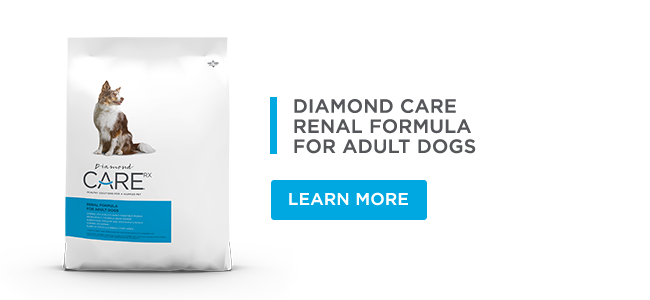A diagnosis of chronic kidney disease (CKD) in your dog can be alarming news. If it’s caught early and if proper treatment is initiated, a dog with CKD may be able to live a relatively normal life for years to come. However, you might have to make some changes to help your buddy live as comfortably as possible.
What Causes Kidney Failure in Dogs?
Any dog can develop kidney disease. Some breeds may have a genetic predisposition to kidney conditions. There are two main types of kidney disease:
- Acute kidney injury, also called acute kidney failure or acute kidney disease, develops suddenly and is often caused by toxins (e.g., antifreeze), infections like leptospirosis, other underlying conditions and trauma.
- Chronic kidney disease, which can also be called chronic kidney failure or chronic renal failure, is a progressive condition that can be associated with genetics, age, toxins, chronic infections and other underlying diseases.
Sometimes, the two conditions coexist.
Symptoms of Chronic Kidney Failure in Dogs
Part of the challenge of recognizing kidney disease in dogs is that dogs may not show any signs of illness in the early stages of the disease. By the time signs of a problem are apparent, 66 to 75 percent of the kidneys’ function may have been lost. Another hurdle to recognizing kidney disease is that the signs seen by pet parents are nonspecific, meaning they can also be associated with other health problems.
Signs of chronic kidney disease include:
- Drinking more water than normal
- Urinating large volumes
- Loss of appetite
- Vomiting
- Diarrhea
- Listlessness
- Weight loss
- Pale gums
Because the signs of kidney disease you may notice can be indicators of other health issues, it’s important to have your dog routinely examined by a veterinarian, and it’s especially important to have your canine companion evaluated if you see any of the signs mentioned. Your veterinarian may find additional indicators of kidney disease on physical examination, such as sores in your dog’s mouth (oral ulcers), dehydration, changes in the retinas of the eyes or abnormally sized kidneys.
Chronic kidney disease in dogs is generally progressive, meaning that once it begins, there’s typically no cure. With early intervention, however, it can be possible to slow the progression of the disease.
Diagnosis of Kidney Disease in Dogs
The kidneys are primarily responsible for filtering out waste products from the blood. As the kidneys begin to fail, they can often compensate, so dogs usually don’t show any clinical signs such as increased thirst and urination in the early stages of the disease.
It’s not until waste products, specifically creatinine (from muscle metabolism) and blood urea nitrogen (a liver byproduct), begin to build up in the blood that abnormalities may surface on traditional screening tests. When the urine-specific gravity, which measures the kidneys’ ability to concentrate urine, is abnormal, a diagnosis of kidney failure is made.
The trouble is that by the time these traditional tests catch kidney disease, the kidneys may have already lost 75 percent of their function.
There is a test that detects symmetric dimethylarginine (SDMA) and may identify kidney disease earlier, since this biological marker rises in the blood earlier than creatinine — on average, the diagnosis can be made when there’s been a 40 percent loss of kidney function. In dogs, that could mean, on average, about 9.5 months earlier than with traditional tests.
Diagnostics such as blood and urine tests, X-rays, ultrasound evaluation and blood pressure measurements will help provide a more complete picture of your dog’s health and allow your veterinarian to create an appropriate treatment plan.
Stages of Chronic Kidney Disease in Dogs
To help veterinarians provide the best care for dogs with CKD, the International Renal Interest Society (IRIS) developed a system to “stage” the disease. It’s not another method for diagnosing CKD, but a way, after diagnosis, to tailor treatment, monitor chronic disease progression and assess patient prognosis.
The IRIS system categorizes stable, hydrated dogs with CKD into four stages, based on blood levels of creatinine, SMDA or, preferably, both:
- Stage I (pre-failure): Dogs typically have normal blood creatinine or normal/slightly elevated SDMA. Kidneys may appear abnormal on X-rays or when veterinarians feel or “palate” the kidneys on examination. Dogs generally don’t show clinical signs.
- Stage II (mild failure): Creatinine is normal or mildly increased and SDMA is mildly increased. Clinical signs may be absent or mild.
- Stage III (moderate failure): Creatinine and SDMA are moderately elevated. Signs may be absent or obvious.
- Stage IV (severe failure): Creatinine and SDMA are extremely elevated. Dogs show signs of illness at this point.
The IRIS staging system also includes treatment recommendations aimed at preserving kidney function (and slowing disease progression) while improving the quality of life for the dog. No matter how far kidney disease progresses, with the IRIS system, your veterinarian can monitor response to treatment and revise the dog’s staging and treatment as needed, and provide a better quality of life for as long as possible.
Early Stages of Kidney Disease in Dogs
With early diagnosis, veterinarians can intervene at stage I or II, when treatments can be more effective at slowing disease progression. However, many dogs may not be diagnosed until they have already reached the latter stages of CKD.
Dogs with CKD need to be examined by their veterinarian far more often than healthy dogs, though the frequency depends on the stage of their CKD. If it’s in the early stages, your vet may want to examine your dog every three months or so. More frequent visits will eventually be required in order to check blood work, urinalysis and blood pressure, and to make sure the right medications are being administered at the right levels.
Late Stage Kidney Disease in Dogs
At this stage, the treatment emphasis is more on helping reduce clinical signs and improving pet comfort. Dogs with CKD, especially in its advanced stages, are typically prescribed a protein- and phosphorus-restricted food. Lower protein is recommended so that the kidneys don’t have as much waste to filter (to prevent waste products from building up in the blood). Since the kidneys aren’t as efficient as they once were, they can’t remove phosphorus like they should, and restricting phosphorus can help limit further damage to the kidneys. Specialized kidney diets, like Diamond CARE Rx Renal Formula for Adult Dogs, are also usually restricted in sodium and supplemented with fatty acids.
Another issue that dogs with renal failure face is decreased appetite. Getting your dog to eat the amount of therapeutic diet that is recommended by your veterinarian is important to preserve the existing kidney function. If your dog isn’t eating their normal-sized meals, try feeding multiple small meals throughout the day. You might even have to hand-feed, warm the food slightly or soak it in water to make it more enticing. That added water might also help prevent dehydration.
How to Comfort a Dog with Kidney Failure
Constant access to clean water is a must for dogs with CKD. To stay hydrated, dogs with kidney disease will need to drink more water than healthy dogs. As a result, they will urinate more frequently and in larger amounts. Ways to increase water consumption include placing bowls of clean water in additional locations around the house or even supplementing the water with a touch of low-sodium chicken broth. If your dog isn’t able to maintain hydration, your vet may recommend giving fluids under the skin.
Since your dog will need to urinate more often, you might have to make new arrangements, especially if you’re not home all the time. If your yard is safe and secure, consider adding a doggy door so they can come and go as they please. If that’s not possible, you might want to ask a neighbor or hire a dog walker to take your dog outside in your extended absence.
This is a more abstract issue, as every dog is stressed out by different things. But when a dog is under stress, they may eat or drink less than usual. Since a dog with CKD needs more water and may have less of an appetite, the last thing you want is anything that lowers that desire to eat and drink. So be sure to monitor your pal for signs of stress and anxiety. Separation anxiety, fear of thunder, that annoying squirrel outside: only you know what’s going to add stress to your dog’s life, and you need to do what you can to lessen it.
People often wonder how long their dog will be able to live with CKD. Because the rate of progression varies considerably among individuals, this is often impossible to predict. Many dogs can live for months to years when their disease is carefully managed by their veterinarian along with a conscientious owner. If your dog is diagnosed with kidney or renal disease, follow your vet’s treatment plan and make their life as comfortable as possible, with plenty of hugs, too.








